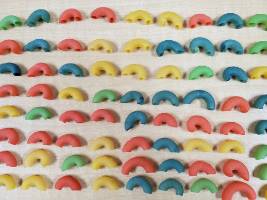Summary
During this lesson, students will use their prior knowledge of multiplication and the distributive property to solve a 2-digit by 2-digit multiplication problem.
Essential Question(s)
How can you use multiplication strategies to solve a story problem?
Snapshot
Engage
Students activate prior knowledge with group discussion and are introduced to the problem.
Explore
"Harvest Strategy": Students create a poster for their solution.
Explain
Students solve story problems with their preferred method.
Extend
"Who Has the Largest?": Students play a card game to practice multiplication.
Evaluate
Students complete an Exit Ticket to evaluate their understanding.
Materials
Story problem handout
Large sheets of bulletin board paper (one per group)
Sticky notes (one per student)
Deck of playing cards with face cards and 10s removed
Craft sticks (optional)
Exit ticket
Engage
Begin by discussing the distributive property to activate students' prior knowledge of multiplication. Ask students, "What does the distributive property look like?" Students may answer the questions through whole group discussion, written/illustrated responses, or by modeling.
Tell students, "I need your help today solving a story problem." Share the following problem with students. You may either use an interactive whiteboard or the attached paper copy (one per group).
Tom builds 36 birdhouses. He used 17 craft sticks to build each birdhouse. How many craft sticks did he use in all?
Explore
Introduce a Strategy Harvest instructional strategy. Within their groups, have students discuss how they would solve the problem. After the students have had time to discuss, ask each group to share out how they would solve the problem and what led them to their decision. Ask students to create a poster illustration showing how they would solve the story problem. Allow students to decide how and what they use to create their poster. Walk around to each group and discuss their plan with them.
When students have completed their posters, hang them around the room. Use a Gallery Walk strategy to allow students to travel to each poster and then answer the following questions:
What do you notice about the posters?
What methods are used to solve the problem?
Are all of the methods the same?
After everyone has traveled to all the posters, students will return to their seats. Have each group explain the method they used to solve the problem.
Give each student a sticky note. Ask students to choose a method they would use to solve the problem and write why they chose that method on their sticky note. Students then place their sticky note on the poster that represents their preferred method.
The following are examples of methods for solving the problem:
Explain
Leave the posters from the Gallery Walk hanging up and over the next day or so, go over each group’s poster. Demonstrate each method for solving the multiplication problem.
After each method has been reviewed, let the students choose a method to use when solving a multiplication problem.
Present each of the problems below. Have students solve each problem on their whiteboards or paper, using a strategy that they prefer. While students are solving the problems, walk around and ask students why they chose their method they are using to solve the problem. Take time to work each or the problems and discuss them as a class.
A pet store sold 74 puppies in one week. If the cost of each of the puppies was 65 dollars, how much money did they collect that week?
Kelli had 56 shelves of DVDs. If each shelf held 38 movies, how many total movies did she have?
Kelsey was making necklaces for her friends. She had 85 friends who wanted a necklace and each necklace required 25 beads. How many beads would she need altogether?
Extend
Teach students to play a card game called, "Who Has the Largest?"
During this activity, students will work with a partner. Each pair of students will get a deck of cards with the face cards and 10s removed. Have the students shuffle their cards and lay them face down.
Each student should draw four cards and arrange them to make a two-digit by two-digit multiplication problem. The goal of the game is to use your cards to design a problem with the highest possible product. Have students solve their own multiplication problem on their scratch paper using their preferred strategy.
After they have solved a problem, students trade papers and check each other’s work. The player with the largest product scores a point. Students keep playing until one person scores ten points or when time runs out.
Evaluate
Use an Exit Ticket strategy to evaluate students' learning.
Each student receives a blank sheet of paper that will serve as their Exit Ticket. You may also use the Exit Ticket template provided. Using a deck of cards from the "Who Has the Largest?" game, draw four playing cards and present them to the class. Have students write the numbers on their paper to create a multiplication problem and solve it using their preferred strategy. After solving the problem, they will explain in writing on their Exit Ticket why the method they used is the best way to solve a multiplication problem.
Use the information from the student's Exit Tickets to organize small groups or one-on-one meetings for students who are still confused or are not confident in the multiplication process.
Resources
K20 Center. (n.d.). Bell ringers and exit tickets. Strategies. Retrieved from https://learn.k20center.ou.edu/strategy/d9908066f654727934df7bf4f505d6f2
K20 Center. (n.d.). Gallery walk / carousel. Strategies. Retrieved from https://learn.k20center.ou.edu/strategy/d9908066f654727934df7bf4f505a54d
K20 Center. (n.d.). Strategy harvest. Strategies. Retrieved from https://learn.k20center.ou.edu/strategy/d9908066f654727934df7bf4f5062662


